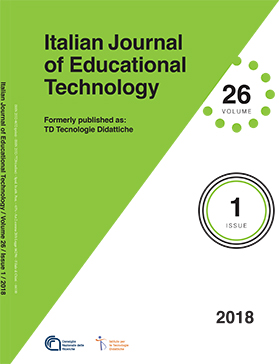A module on Learning Technologies for teachers in Higher Education
Main Article Content
Abstract
This paper describes a 10 European Credit Transfer and Accumulation System (ECTS ) module in Learning Technologies which forms part of a Post Graduate Diploma in Academic Practice, part of a professional development framework for academic staff. The module, which is taught through seven themed workshops over one semester, is research-informed and practice-based. Assessment is on a pass/fail basis and includes three aspects supporting reflection, technical competency and the implementation of a technology-based project. Throughout the module, technology is used as a showcase for the module content itself. The intention is to integrate the use of technology to support the pedagogy, without over-using technology for its own sake. Through surveying past participants on the module there is evidence to suggest that good practice in the use of technology is being embedded in teaching and learning activities across the university.
Article Details
Section
Authors who publish with this journal agree to the following terms:
- Authors retain copyright and grant the journal right of first publication with the work simultaneously licensed under a Creative Commons CC BY 4.0 Attribution 4.0 International License.
- Authors are able to enter into separate, additional contractual arrangements for the non-exclusive distribution of the journal's published version of the work (e.g., post it to an institutional repository or publish it in a book), with an acknowledgement of its initial publication in this journal.
- Authors are permitted and encouraged to post their work online (e.g., in institutional repositories or on their website) prior to and during the submission process, as it can lead to productive exchanges, as well as earlier and greater citation of published work (See The Effect of Open Access)
References
Brickner, D. (1995). The effects of first and second-order barriers to change on the degree and nature of computer usage of mathematics teachers: A case study. West Lafayette, IN: Purdue University.
Cronin, C. (2017). Openness and Praxis: Exploring the Use of Open Educational Practices in Higher Education. International Review of Research in Open and Distributed Learning, 18(5), 15-34. doi: 10.19173/irrodl.v18i5.3096
Ertmer, P. (1999). Addressing first- and second-order barriers to change: Strategies for technology integration. Educational Technology Research and Development, 47(4), 47-61. doi: 10.1007/BF02299597
Flynn, S. (2015). Learning Technologists: Changing the Culture or Preaching to the Converted? In D. Hopkins (Ed.), The Really Useful #EdTech Book (p. 199-217). David Hopkins.
Hamilton, E. R., Rosenberg, J. M., & Akcaoglu, M. (2016). The Substitution Augmentation Modification
Redefinition (SAMR) Model: a Critical Review and Suggestions for its Use. TechTrends, 60(5), 433-441. doi: 10.1007/s11528-016-0091-y
Koehler, M. J., & Mishra, P. (2009). What is technological pedagogical content knowledge?. Contemporary Issues in Technology and Teacher Education, 9(1). Retrieved from http://www.citejournal.org/volume-9/issue-1-09/general/what-is-technological-pedagogicalcontent-knowledge/
Laurillard, D. (2012). Teaching as a Design Science: Building Pedagogical Patterns for Learning and Technology. London, UK: Routledge.
Reid, P. (2014). Categories for barriers to adoption of instructional technologies. Education and Information Technologies, 19(2), 383-407. doi: 10.1007/s10639-012-9222-z
Selwyn, N. (2017). Education and Technology: Key Issues and Debates (2nd ed.). London, UK: Bloomsbury Academic.
Wheeler, S. (2012, March 13). New ideas in a digital age.
Retrieved from http://www.steve-wheeler. co.uk/2012/03/new-ideas-in-digital-age.html
White, D., & Le Cornu, A. (2012). Visitors and Residents: A new typology for online engagement. First Monday, 16(9). doi: 10.5210/fm.v16i9.3171

